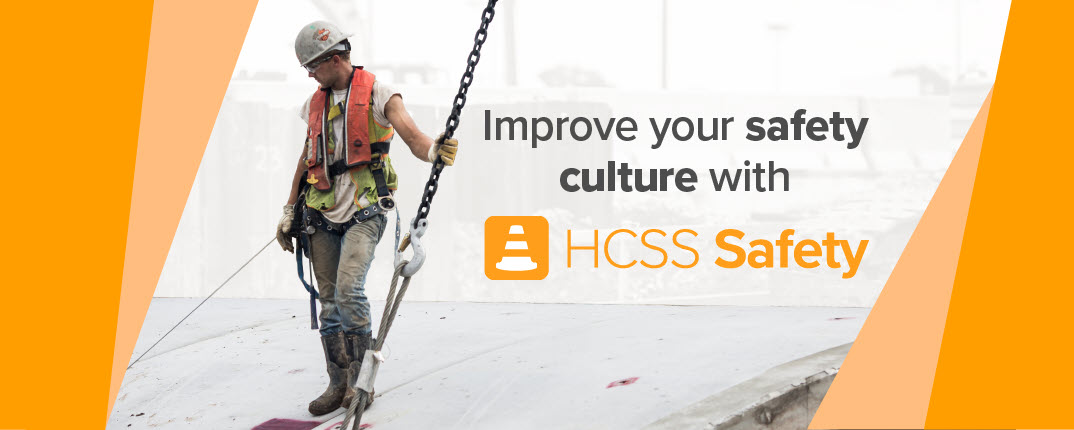Just like HCSS loves to praise customers for their massive wins in the industry, so do patrons of the world’s most trusted construction software platform enjoy giving HCSS a shoutout in return. We caught up with a variety of construction professionals to ask them specifically about their experience using HCSS Safety. Here’s what they had to say!
Making JHAs as Easy as Possible
The UX team at HCSS is home to some of the brightest minds in the software business, consisting of developers who understand that running a job hazard analysis (JHA) daily is far more likely to become routine when it’s convenient. HCSS Safety compiles well over a thousand pre-built JHA templates for easy use.
“The JHA in the [HCSS] safety product is the best JHA in the market,” says Jake Anderson, Project Control Manager for Austin Bridge & Road. “We believe that's making us safer, allowing our foremen to tailor-make a JHA for their day, their activities.”

Echoing the same sentiment is Hannah Wiertzema, a Project Manager for Nabholz Construction in Conway, Arkansas. “We can get the JHAs straight out of their diaries, and be able to pull those into a report right away,” she comments. “That’s something that we have to do every month for our owners, especially the ones we’re currently working with. That way, we can have that information right away. It also allows us to see if they’re being done.”
As one of the HSE Superintendents for Colas USA, Sarah Dow and her team have been using HCSS Safety heavily for the past 5 years. During that time, their use of technology has been significantly ramped up.
“When I first started as a safety superintendent, I don’t think we had any iPads in the field at the foreman level,” Dow says. “Now every foreman has an iPad, every traffic control supervisor has an iPad, and any control lead has an iPad so that they can do their daily meetings, their JHAs, observations, [and] near misses. We have implemented a matrix. If you’re the frontlines foreman, you have to do a daily meeting every day. You have to do a JHA every time you do a new task, which should be once or twice a week.”
Jake Anderson notes a similar practice, being able to efficiently monitor performance and better enforce best practices. “It’s allowed us to see who’s not engaging over a quarter, who isn't doing a safety inspection once a week on average, which is our policy,” he says. “It’s allowing us to gauge who’s willing to be a part of our safety culture and who is checking a box. And we can have conversations with them about why they don’t think safety is important. It’s allowing us to coach and mentor people.”

Of course, all of this process means nothing if it isn’t achieving the #1 goal – to better protect workers on the job, getting them home to their families every night.
“We believe that the HCSS Safety product is making us safer,” Anderson asserts. “It’s giving us the data we need to go and make good decisions in our organization.”
Maximizing the Skills Feature
Being able to use HCSS Safety to input the skills and certifications of every employee and instantly view who is qualified for the job and who isn’t – plus be able to request the right operator immediately – is another convenient feature that jobsite managers would hate to go back to working without.

“The fact that we can do a JHA now and then have that earmarked so it’s a skill, allows everybody to see what different employees have under their belt, so they've been proficiently trained as best we can to those high-risk, high-incident rate tasks,” says Sarah Dow of Colas. “We now know they've had a JHA, they’ve had a meeting, and then the skills prove it. We can look up each employee and verify what they’ve been taught and trained, and make sure they’re doing the right things that they should be doing.”
David Ristedt, Safety Manager for Preston Pipelines Infrastructure, doesn’t hesitate either when questioned about what feature he uses the most in the software.
“I would have to say my favorite [HCSS] Safety feature is definitely the Skills tab,” he answers, “simply because I can look up any employee within the company and verify they have been properly trained. For instance, looking up an employee to see if he’s been confined space-trained. Then you’re able to actually open up attachments and look at the certificate for the employee.”

If there is ever an on-site audit, being able to pull up all of these skills and certs at the drop of a hat is invaluable. Similarly, being enabled with the tools to meet 100% of all data compliance is something companies cherish about the program. Just ask KE&G.
“It’s been a great tool for us to be able to help get the data and get the information we have,” says Chris Albright, President of KE&G Construction. “Then we can do that tailored training, and we can do it really quickly. We’ve got set information that comes out weekly, scheduled, so those guys attend their meetings and we get not only the support to the guys in the field, but also the data compliance for ADOSH, OSHA, MSHA – all those people we’re working with – to make sure we've got the backup as well.
Lowering Your EMR Rating with the Help of HCSS Safety
A company’s experience modification rate (EMR) is also a key method for keeping insurance affordable and maintaining profitability on jobs – this is why your EMR is so important.
“[HCSS] Safety helps us with our EMR rating,” David Ristedt points out. “The goal is always to be below the industry – the industry is at 1.0 – so we always like to attain below 1.0. We track all our incidents, all our near misses, and we can look at trends and know where we’re lacking, where we’re not, and that helps us out.”
On that same note, Chris Albright was quick to discuss their vastly improved EMR as well.

“Our EMR has dropped,” he says. “We have taken our analysis of safety from more accidents to incidents. The incidents we’re tracking are even smaller now. We’re seeing more indicators – trying to fix those earlier – that we weren’t seeing before, because we’re getting the incident reports quicker.”
Victoria Hoyt is the VP overseeing HSE for Colas USA. She previously used HCSS when working for a different company and became enamored with how great the software is for tracking leading indicators.
“When I came to Colas, one of the first things I did was look at our system that we were using, and it really didn’t have the ability to track any leading indicators,” Hoyt recalls. “The training modules weren’t that great. That was probably the first thing I implemented. We were already using HCSS, so getting the Safety module was really easy to do.”

Originally beginning her career as a carpenter who worked in the field, Hoyt has a strong feel for what works and what doesn’t. “It’s just so intuitive,” she adds. “We want it simple, effective, and everyone loves it in the field. That’s the main thing. But the reporting is easy for someone who’s not an IT person to pull reports and to use the data.”
Transforming Your Safety Culture
For Preston Pipelines, Ristedt’s goal is to positively influence a safety culture that everybody is a part of and wants to continue improving.

“I would say that HCSS has definitely helped us take better control of our jobsites and just the overall safety culture,” he says. “From the very beginning, in the morning, the foreman creates a morning meeting, and we have a wake-up meeting. We can bring in all of the JHAs, everybody reads over them, and they sign off on them. You can take pictures, so we do our stretch-and-flex in the morning, taking pictures of that. It’s seamless. It’s all there. Guys know what to expect. That really helps us check the boxes, so to speak. It makes a big difference in our safety culture. When everybody signs off on meetings and inspections, we can go back and double-check to make sure things submitted got done.”
Ready to Get Started?
If you want to get started experiencing all that HCSS Safety can do for your teams, request more software info, and we’ll have an expert reach out to you pronto. We look forward to helping your operation get to the next level!



